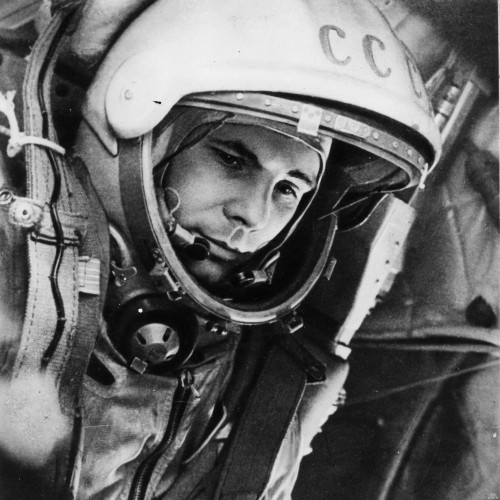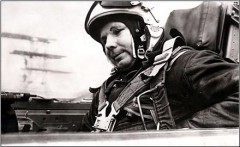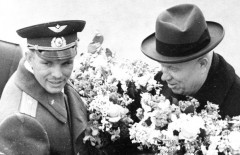
Last week’s announcement that “the truth” had finally emerged about the mysterious death of Yuri Gagarin—the first man in space—seemed at first to hasten yet another dry and dull conspiracy theory. Forty-five years after Gagarin and his instructor, veteran test pilot Vladimir Seregin, lost their lives in the 27 March 1968 crash of a MiG-15 training jet, it appeared that all possibilities of what happened had been exhausted. Theories ran the gamut from basic pilot error to a bird strike or a collision with a hot-air balloon … and even more outlandish tales of drunkenness or taking potshots at wild deer or even a conspiracy organized by the upper echelons of the Kremlin itself. The consensus, supported and endorsed by cosmonaut Alexei Leonov, focuses on events already in the public domain, but allows the circumstances of that dreadful day to be finally laid to rest.
Reported by RT.com, last week’s revelation does not really contribute much significance to what is already known or suspected about the tragic flight. Central to the new theory is that a supersonic Su-15 jet was conducting exercises in the close vicinity of Gagarin and Seregin’s aircraft, but was operating at much lower altitude than it operationally should have been. “We knew that a Su-15 was scheduled to be tested that day,” said fellow cosmonaut Alexei Leonov, the world’s first spacewalker and a close friend of Gagarin, “but it was supposed to be flying at an altitude of 10,000 meters or higher … not 450-500 meters. It was a violation of the flight procedure.”
As described in this AmericaSpace article, Gagarin and Seregin took off from Chkalovskaya airfield, near Moscow, in the antiquated MiG-15UTI trainer and conducted a program of simple turns, pitch maneuvers, and nose-dives. Shortly afterwards, Gagarin requested permission to commence his descent. “That was the last we heard from him,” Leonov told RT. “The control point recorded that he was at the altitude of 4,200 [meters] at the time … 55 seconds later, the plane crashed.” At 10:31 a.m. Moscow Time—a time famously immortalized by the frozen clock in Gagarin’s Star City office—all contact with the MiG-15 was lost.

At the time of the incident, Leonov was overseeing parachute jumps from a helicopter near Kirzach airfield, in the Moscow region. “The weather was very bad that day,” he wrote in his memoir, Two Sides of the Moon, co-authored with Apollo astronaut Dave Scott. “The cloud cover was low and it was raining hard. My team had performed just one jump when the weather deteriorated even further. The rain turned to sleet and conditions were so bad that I canceled the session and requested permission to return to base.” As he waited to learn if his request had been granted, Leonov heard two loud bangs from the distance. One was clearly an explosion, the second a sonic boom, with a second or so between them.
During his return to base, he was puzzled by the control tower’s continued (and unanswered) radio calls to Gagarin and Seregin. Upon landing, Leonov reported hearing the explosions and a search team was despatched. The MiG-15 impacted close to the village of Novoselovo, about 64 km from its airfield of origin. The team found some remains of Seregin—notably an upper jaw—but nothing of Gagarin, save “his map case and a purse.” According to Leonov, this kindled some hope that the First Cosmonaut had managed to eject and had survived. “We sent a battalion of soldiers, who combed the forest for the whole night,” he was quoted by RT.com. “They shouted so that he could hear them, but all they found were remains of a balloon.”
Writing in Two Sides of the Moon, Leonov explained that the MiG-15 debris was scattered in a wooded area and the aircraft’s engine was buried several meters underground. It was determined that the MiG’s impact velocity was around 750 km/h. Early the following morning, 29 March, a piece of cloth from Gagarin’s flight jacket, hanging from a birch tree, offered the first proof that the First Cosmonaut had died. The remains subsequently discovered were identified as “fingers, toes, pieces of ribcage, and skull” by Jamie Doran and Piers Bizony in Starman, their 1998 biography of Gagarin.
Many times over the years, Leonov has recounted the horrific realization that the remains were indeed those of his friend. Fragments of flesh recovered from the crash site were placed into a metallic bowl. “A few days before,” he wrote, “I had accompanied Yuri to the barber to have his hair cut. I had stood behind Yuri talking while the barber worked. When he came to trim the hairs at the base of Yuri’s neck, he noticed a large, dark brown mole.” Leonov joked that the barber should be careful not to cut the mole, little realising that it would prove pivotal in identifying the remains of Gagarin. “Looking down at the fragments of flesh lying in that metal bowl,” Leonov wrote, “I saw that one bore the mole.”

In the aftermath of the disaster, an investigative commission was convened and Leonov and fellow cosmonaut Gherman Titov—the Soviet Union’s second man in space—were called upon as expert witnesses. Early theories as to the primary cause included a bird strike, a collision with the hot-air balloon, and the presence of the Su-15. More outlandish possibilities, aired over the years, included outrageous notions that Gagarin was drunk or that Seregin was taking potshots at wild deer from the MiG’s cockpit or even that Soviet General Secretary Leonid Brezhnev himself had imprisoned the First Cosmonaut after having cognac thrown in his face.
When the official accident report emerged in December 1968, it pointed definitively toward “pilot error,” but when classified files were reopened two decades later, the presence of the Su-15 took center stage. In his remarks to RT.com, Leonov noted that he had spoken to eyewitnesses on the day of the crash, who related that they saw the Su-15 emerging from the clouds with smoke and flame emerging from its tail.
Back in 1998, Doran and Bizony explained that Gagarin and Seregin had inaccurate altitude data and had flown into an area where the Su-15 was operating. In Two Sides of the Moon, Leonov wrote that the Su-15 pilot “violated the rules and dipped below the cloud cover for orientation,” prompting the close encounter at a distance of 10-15 meters with the MiG. The air turbulence associated with the supersonic jet breaking the sound barrier effectively “turned” the MiG and initiated a deep spiral, which saw Gagarin and Seregin plunge helplessly to Earth at 750 km/h. Inaccurate altitude data meant that the two pilots thought they were higher than they really were and were thus unable to initiate ejection in a timely fashion.
None of this is “new” or even profoundly Earth-shattering. What was unexpected were the various inconsistencies discovered by Leonov during his own 20-year-plus exploration of the events of that tragic day. His signed statement had apparently been altered and its facts jumbled. “It had been something like this,” he was quoted by RT.com. “Marked here was a sonic spike—a blast—followed by one-and-a-half or two seconds of supersonic noise. When I looked at the copy, I suddenly noticed that it stated this noise interval to be 15-20 seconds long, instead of the two seconds that I had reported. That suggested that the two jets must have been no less than 50 km apart.” Modern computers enabled a new investigation to begin, in which Gagarin and Seregin’s 55-second plunge to the ground and the 750 km/h impact velocity were inputted.
The result was that the MiG had entered a deep spiral. “Now, a jet can sink into a deep spiral if a larger, heavier aircraft passes too close and flips it over with its backwash,” Leonov concluded. “That is exactly what happened to Gagarin. That trajectory was the only one that corresponded with all our input parameters.” As to the reason for covering up this tragic turn of events, Leonov suspected that the Kremlin was reluctant to admit to “such a lapse, so close to Moscow.” The Su-15 pilot ultimately responsible—today in his eighties—for causing the death of the first man to conquer space was identified, but is in frail health. One of the preconditions for Leonov going public was apparently that the name of the Su-15 pilot would not be disclosed.
It is a precondition with which Leonov readily agrees. “He is a good test pilot,” he told RT.com. “It will fix nothing.”
In light of these new findings, little “new” information may have emerged: it had been known for some time about the presence of the Su-15 and its likely involvement in sending Gagarin and Seregin’s jet into a catastrophic and uncontrollable spin. It was not known that the Su-15 pilot had been identified and was still alive, nor was it known with certainty that a conscious effort to suppress the details had been made. What is known, however, is that Yuri Alexeyevich Gagarin achieved an enormous amount in his short life, but ended his days in an ignominious accident, which could easily have been avoided.
Gagarin reached the most exalted heights possible for a human being … and died long before his time.
Want to keep up-to-date with all things space? Be sure to “Like” AmericaSpace on Facebook and follow us on Twitter:@AmericaSpace




Ben – you have wriiten yet another excellent historical piece. The details of the Su-15 involvement in Gagarin’s crash puts to rest, once and for all, the circumstances of this tragic event. It would be of historical interest to know who the pilot was, but I believe Leonov is correct in his assertion that “it will fix nothing.”
I agree Tom, Ben has once again done an excellent job in sifting through decades old evidence to assemble an accurate, unbiased conclusion. Pilots can, and do, make mistakes. A young new pilot, 19 years old and just accepted to the U.S. Naval Academy, was killed yesterday here in Detroit with three family members when his overweight aircraft crashed shortly after take-off. In 1966 Elliott See and Thomas Bassett were killed when their T-38 crashed into McDonnell Aircraft Bldg. 101 in St. Louis, Missouri. NASA investigators found the primary cause of the crash to be pilot error caused by poor visibility due to bad weather. See was flying too low to the ground, and he and Bassett died some 500 feet from their Gemini 9 spacecraft. Also, this was not an era known for transparency, be it Francis Gary Powers and the U-2 incident, the Bay of Pigs, or the tragic loss of the world-class hero, “The First Cosmonaut”. It is important to remember and keep in perspective the difficulty faced by “history detectives” such as Ben Evans in light of events such as the Kennedy assassination which took place on a bright, clear, sunny day in front of hundreds of witnesses, many of whom were skilled observers from law enforcement. Despite hundreds of thousands of hours of investigation and analysis of every shard of evidence, there is still “the grassy knoll” and “the magic bullet.” It didn’t even take a year for the first 9/11 World Trade Center disaster conspiracy to arise. Ben, I wholeheartedly agree with Tom: “you have written yet another excellent historical piece.”
Karol, nutcase conspiracy theories are like black holes: they draw every bit of logic and logical evidence inside them, twisting and turning them, and eventually making them part of their own. So the best anyone can do, is just stay away from their ‘event’ horizons!
This is still an odd story – as a pilot myself, you are always looking for other traffic. And you would be out doing testing with weather like that? Certainly Europe does not have the CAVU conditions that Arizona has (for instance) but that just sounds very odd. And the Russians are very dedicated to having aircraft under ground control at all times, how would they have not seen the two aircraft flying so closely?
So this new story tells us that at least two aircraft were out in really unacceptable weather, did not know that the other was there, and one flew right in front of the other? There was no collision? And both were accidentally flying far too low? So when the MiG 15 went into a flat spin, it could not recover?
Sounds like a long series of enormous mistakes were made, or perhaps this is just another invented story.
Withholding the truth is rarely useful. We need to learn from our mistakes, so that others don’t suffer the same outcome. Not necessary to ‘blame’ the Su-15 pilot, just add his inadvertent action to a ‘don’t do this’ Su-15 flight protocol.